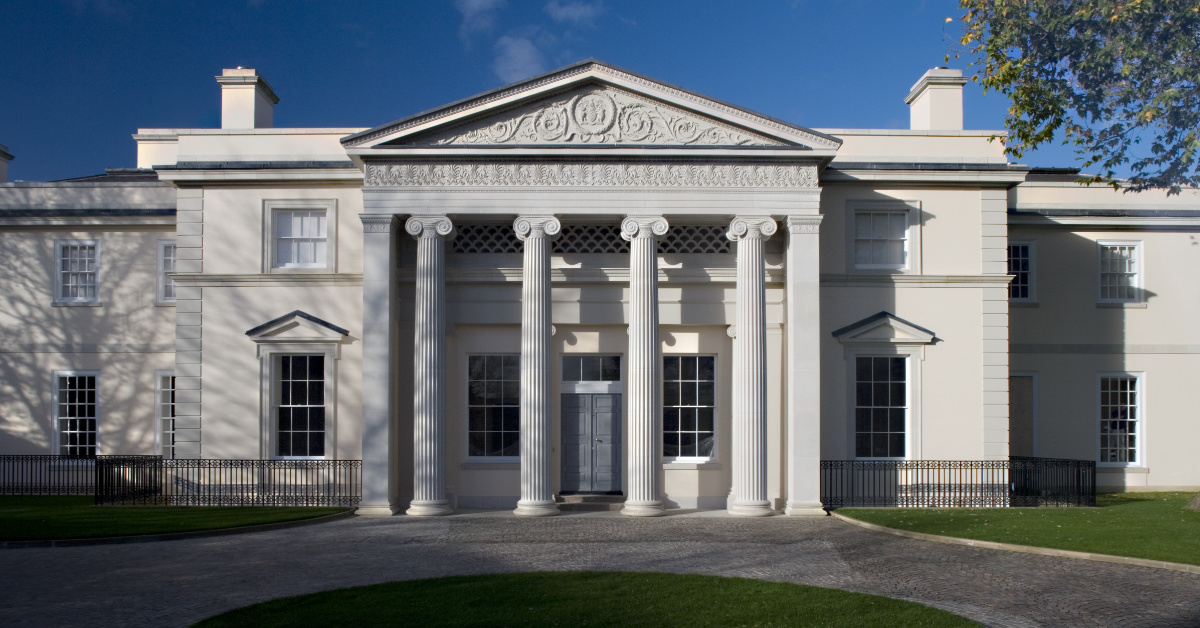Howard Theatre
Howard Theatre, Downing College, Cambridge
Howard Theatre, built in 2009-10 of Ketton stone, completes Howard Court of which Quinlan and Francis Terry built the north and west sides in 1986 and 1994 respectively. The Theatre is housed in a seven-bay long, three-storeyed range which fills the south side of Howard Court and is in axis with the Howard Building of 1986 opposite. All three sides of this handsome new court feature a colonnade or loggia with columns in a version of Greek Doric and capitals with Roman astragals, supporting a triglyph frieze and a balustrade, a Renaissance invention based here on one which Quinlan Terry had admired and drawn in 1982 at the Piazza della Madonna at Loreto by Bramante.
Howard Theatre has an intimate and sociable interior with two tiers of galleries divided by Tuscan piers, a disposition which draws on the seating arrangements of Georgian theatres like the Theatre Royal at Richmond, Yorkshire (1788), and to a lesser extent that at Bury St Edmunds, Suffolk (1819), by William Wilkins. He was the original architect of Downing College in 1807-20 which was an early example of the Greek Revival. Francis Terry has thus ingeniously made the interior of the Theatre a tribute to the Greek Revival from the eighteenth century to the present day, beginning with his stunning panoramic painting on the safety curtain. This depicts the Acropolis in Athens, including the Propylaea and the Parthenon but to which he unexpectedly adds two buildings at Downing College: the west range of the court by Wilkins and the Maitland Robinson Library by Quinlan and Francis Terry of 1990-92. He contrived to fit in below this an image of the powerfully rusticated entrance archway of Wilkins’s Gaol at Bury St Edmunds of 1819.
Francis Terry has also decorated the ceiling and its coves with paintings continuing the Grecian theme. These include over the proscenium a tour de force in the form of a brightly coloured copy of one of the iconic paintings of eighteenth century neo-classicism, Anton Rafael Mengs’ elliptical representation of Parnassus on the ceiling of the gallery at the Villa Albani, Rome, of 1761. In this depiction of Apollo and the Muses, Apollo stands next to one of the earliest images in art of a baseless, fluted, Greek Doric column. This was probably included at the suggestion of Winckelmann, the father of art history, whose Reflections Concerning the Imitation of the Grecian Artists in Painting and Sculpture (1755) played a key role in promoting the Greek Revival.
The three remaining coves of the ceiling have elaborate decoration by Francis Terry incorporating large, animated griffins, part eagle, part lion, which feature on the coat of arms of Downing College. Painted in trompe l’oeil they are convincingly three-dimensional. Terry had already incorporated them in stuccowork decoration in the staircase hall of the Maitland Robinson Library at Downing. In the ceiling itself he painted the central oval as a sky with, in each of the four spandrels, a wreath derived from those on the Choragic Monument of Thrasyllus in Athens which Wilkins incorporated in his own buildings. All this decorative poetry is included in a building in which issues of sustainability were taken very seriously and included a ground source heat pump and solar panels.
Taken from The Practice Of Classical Architecture by Professor David Watkin, Published by Rizolli, 2015









